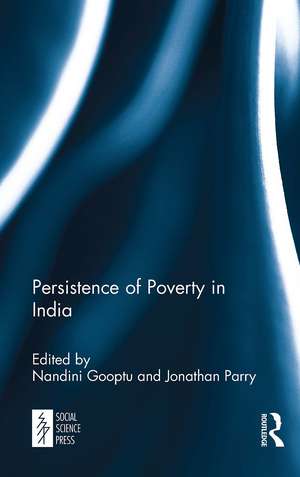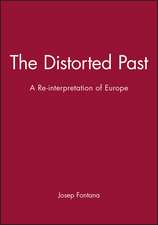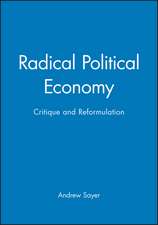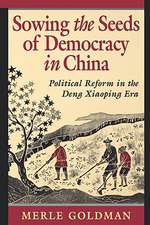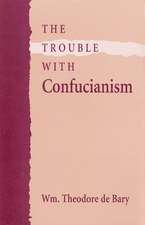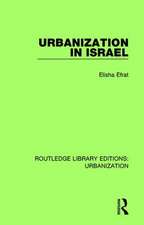Persistence of Poverty in India
Editat de Nandini Gooptu, Jonathan Parryen Limba Engleză Paperback – 25 iun 2024
| Toate formatele și edițiile | Preț | Express |
|---|---|---|
| Paperback (1) | 258.91 lei 6-8 săpt. | |
| Taylor & Francis – 25 iun 2024 | 258.91 lei 6-8 săpt. | |
| Hardback (1) | 983.38 lei 6-8 săpt. | |
| Taylor & Francis – 18 iul 2017 | 983.38 lei 6-8 săpt. |
Preț: 258.91 lei
Preț vechi: 310.85 lei
-17% Nou
Puncte Express: 388
Preț estimativ în valută:
49.57€ • 51.62$ • 41.13£
49.57€ • 51.62$ • 41.13£
Carte tipărită la comandă
Livrare economică 13-27 februarie
Preluare comenzi: 021 569.72.76
Specificații
ISBN-13: 9781032652580
ISBN-10: 1032652586
Pagini: 446
Dimensiuni: 138 x 216 mm
Greutate: 0.4 kg
Ediția:1
Editura: Taylor & Francis
Colecția Routledge
Locul publicării:Oxford, United Kingdom
ISBN-10: 1032652586
Pagini: 446
Dimensiuni: 138 x 216 mm
Greutate: 0.4 kg
Ediția:1
Editura: Taylor & Francis
Colecția Routledge
Locul publicării:Oxford, United Kingdom
Public țintă
PostgraduateCuprins
1. Jonathan Parry, Introduction: On the Persistence of Poverty in India
Part I: Identifying the poor 2. Nandini Gooptu, The Construction of Poverty and the Poor in Colonial and Post-Colonial India: An Overview 3. Himanshu and Kunal Sen, Poverty in India: Measurement, patterns and determinants 4. Penny Vera- Sanso, Reconceiving the Impact of Population Change: A Class- and Gender-based Analysis of Ageing in Poverty in Urban South India
Part II: Targeting the poor 5. Dipankar Gupta, From Poverty to Poverty: Policies for Translating Growth into Development in India 6. Jos Mooij, Redressing Poverty and Enhancing Social Development: Trends in India’s Welfare Regime
Part III: Empowering the poor 7. Peggy Froerer, Poverty and Education in Rural Chhattisgarh 8. Arild Ruud, Notions of Rights and State Benefits in Village West Bengal 9. Indrajit Roy, Flaunted Transcripts: Shaming Elites and Interrogating Domination in Bihar
Part IV: Controlling the poor 10. David Picherit, Neither a Dog, nor a Beggar: Seasonal Labour Migration, Development, and Poverty in Andhra Pradesh 11. Julia Eckert, Preventive Laws and the Policing of the Urban Poor
Part V: The improving lot of the poor? 12. Surinder S. Jodhka, What’s Happening to the Rural? Revisiting ‘marginalities’ and‘dominance’ in North-West India 13. Staffan Lindberg, Venkatesh B. Athreya, Göran Djurfeldt, A. Rajagopal, and R. Vidyasagar,
Progress over the Long Haul: Dynamics of Agrarian Change in the Kaveri Delta 14. Barbara Harriss-White, The Dynamic Political Economy of Persistent South Asian Poverty 15. Dwaipayan Bhattacharyya, How to Govern the Poor: The Role of Social Policies in Economic Transformation
Part I: Identifying the poor 2. Nandini Gooptu, The Construction of Poverty and the Poor in Colonial and Post-Colonial India: An Overview 3. Himanshu and Kunal Sen, Poverty in India: Measurement, patterns and determinants 4. Penny Vera- Sanso, Reconceiving the Impact of Population Change: A Class- and Gender-based Analysis of Ageing in Poverty in Urban South India
Part II: Targeting the poor 5. Dipankar Gupta, From Poverty to Poverty: Policies for Translating Growth into Development in India 6. Jos Mooij, Redressing Poverty and Enhancing Social Development: Trends in India’s Welfare Regime
Part III: Empowering the poor 7. Peggy Froerer, Poverty and Education in Rural Chhattisgarh 8. Arild Ruud, Notions of Rights and State Benefits in Village West Bengal 9. Indrajit Roy, Flaunted Transcripts: Shaming Elites and Interrogating Domination in Bihar
Part IV: Controlling the poor 10. David Picherit, Neither a Dog, nor a Beggar: Seasonal Labour Migration, Development, and Poverty in Andhra Pradesh 11. Julia Eckert, Preventive Laws and the Policing of the Urban Poor
Part V: The improving lot of the poor? 12. Surinder S. Jodhka, What’s Happening to the Rural? Revisiting ‘marginalities’ and‘dominance’ in North-West India 13. Staffan Lindberg, Venkatesh B. Athreya, Göran Djurfeldt, A. Rajagopal, and R. Vidyasagar,
Progress over the Long Haul: Dynamics of Agrarian Change in the Kaveri Delta 14. Barbara Harriss-White, The Dynamic Political Economy of Persistent South Asian Poverty 15. Dwaipayan Bhattacharyya, How to Govern the Poor: The Role of Social Policies in Economic Transformation
Notă biografică
Nandini Gooptu is Fellow of St Antony’s College, Oxford, and currently Head of the Department of International Development at Oxford University. She is the author of The Politics of the Urban Poor in Early-Twentieth Century India (Cambridge University Press, 2001) and several highly acclaimed edited volumes.
Jonathan Parry is Emeritus Professor of Anthropology at the London School of Economics and Political Science. He is the author of Caste and Kinship in Kangra (Routledge 1979), Death in Banaras (Cambridge University Press, 1994), and several distinguished edited volumes.
Jonathan Parry is Emeritus Professor of Anthropology at the London School of Economics and Political Science. He is the author of Caste and Kinship in Kangra (Routledge 1979), Death in Banaras (Cambridge University Press, 1994), and several distinguished edited volumes.
Descriere
What distinguishes Persistence of Poverty from most other poverty studies is the way in which it conceptualises the problem. This volume offers a variety of alternative analytical perspectives and fresh insights into poverty that are key to addressing the problem. In looking at the day to day lived realities of the poor the volume points out that i
